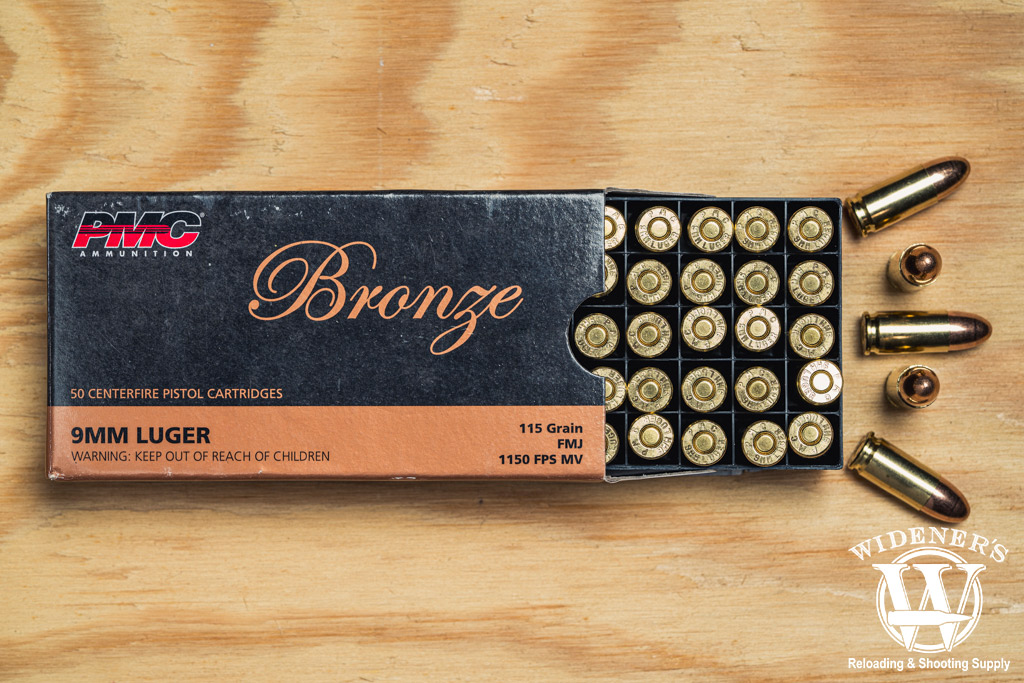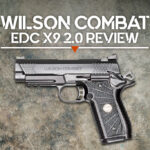
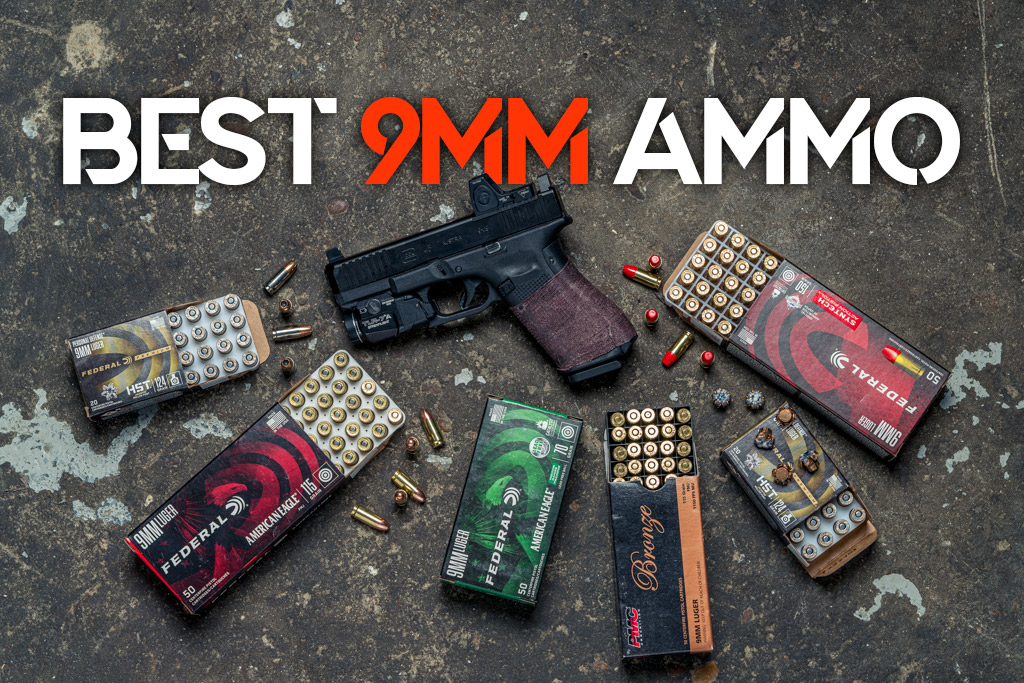
Without question, the 9mm cartridge is the best-selling pistol cartridge in the world. This isn’t a surprise, it’s the NATO standard. Used by roughly 30 nations as their preferred military sidearm caliber. The U.S. military alone has several million 9mm pistols and stores billions of rounds of 9mm for the Armed Forces to train with and use during deployment. So, how do you choose the best 9mm ammo? We’ll cover all that, and more in the article below.
Around 60% of U.S. law enforcement agencies employ the 9mm, and it’s the most popular concealed carry caliber. So what exactly makes it the most popular handgun caliber? The 9mm is the versatile Jack-of-all-trades, doing a little bit of everything, and doing it all pretty darn well. What do we mean by that? Keep reading below:
Best 9mm Ammo
Best 9mm Plinking Ammo
If you’re headed to the range to do some plinking, here are a few suggestions on what to bring. Sure, you could always pick up a case of the cheap stuff, but then you’ll be spending the rest of the night cleaning guns.
PMC Bronze 9mm 115 Grain FMJ
PMC has done a good job of quietly becoming a very popular, cost-efficient brand. Chances are, if you know a competition shooter, PMC is their brand of choice for training at the range. If you didn’t know already, PMC ammunition is loaded in South Korea and uses non-corrosive Boxer primers.
Their full metal jacket ammunition provides numbers familiar to 9mm shooters. PMC (Poongsan) is a major defense contractor that produces its own propellant, brass, and other components for optimal quality control. You won’t have any issues with quality control, or performance while you’re plinking and training to improve your skills.
| Caliber | Bullet Type | Bullet Weight | Velocity (Muzzle) | Energy (Muzzle) | 25 Yards (Velocity/Energy) | 50 Yards (Velocity/Energy) | 100 Yards (Velocity/Energy) |
|---|---|---|---|---|---|---|---|
| 9mm | FMJ | 115gr | 1,150 FPS | 338 FT LBS | 1,099 FPS/308 FT LBS | 1,057 FPS/285 FT LBS | 988 FPS/249 FT LBS |




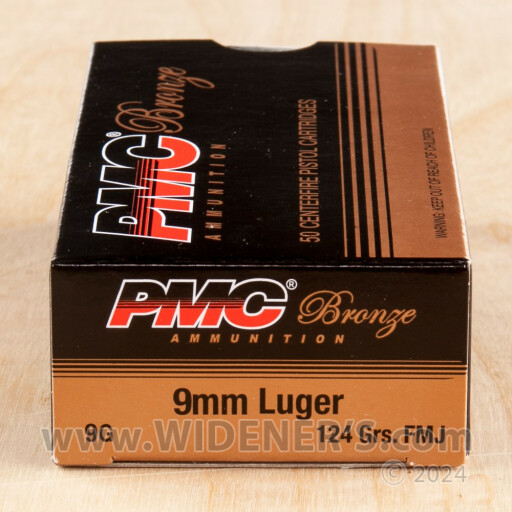


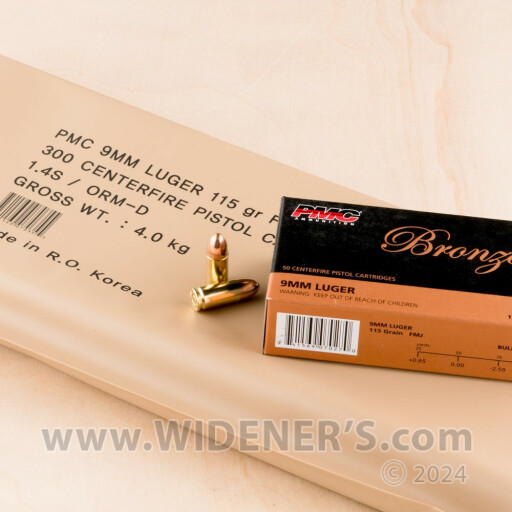


Federal American Eagle 9mm 115 Grain FMJ
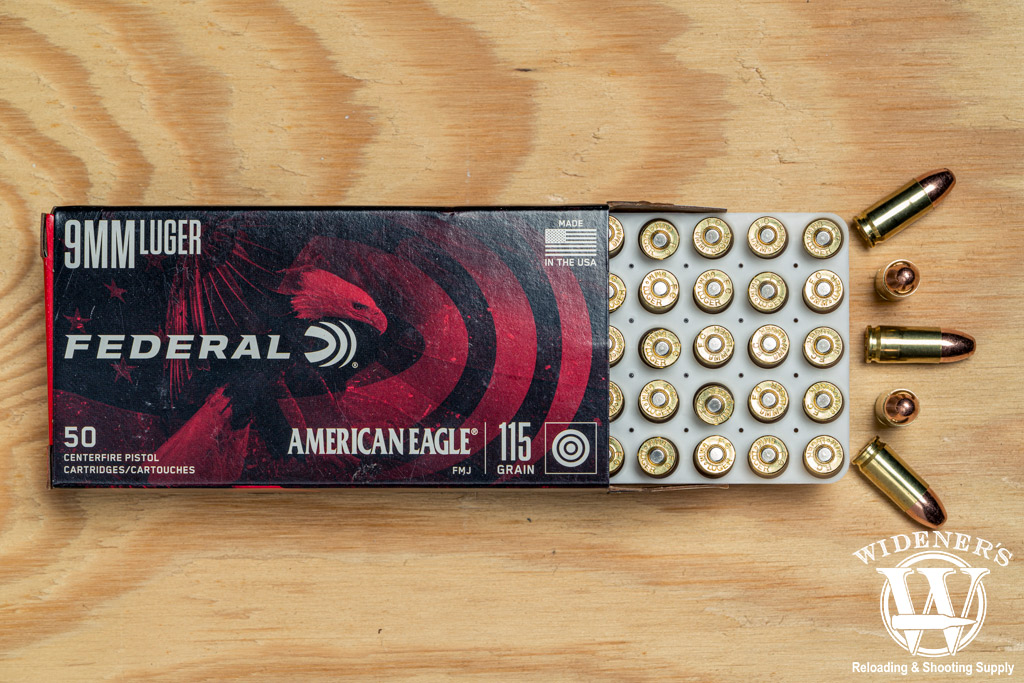
Federal Ammunition has been providing quality products with a technological edge since 1922.
Exiting the muzzle at 1,180ft/s with 356 ft/lbs of energy, this is a good candidate to hone your skills as a marksman. Also, this is a fine candidate to use in a carbine for pest control. Cheaper than .223 ball ammo (and much quieter) but with much more punch than a .22lr, 9mm carbines are a great bridge carbine for the homestead and this round is about perfect for the role.
| Caliber | Bullet Type | Bullet Weight | Velocity (Muzzle) | Energy (Muzzle) | 25 Yards (Velocity/Energy) | 50 Yards (Velocity/Energy) | 100 Yards (Velocity/Energy) |
|---|---|---|---|---|---|---|---|
| 9mm | FMJ | 115gr | 1,180 FPS | 356 FT LBS | 1,106 FPS/312 FT LBS | 1,048 FPS/280 FT LBS | 961 FPS/236 FT LBS |
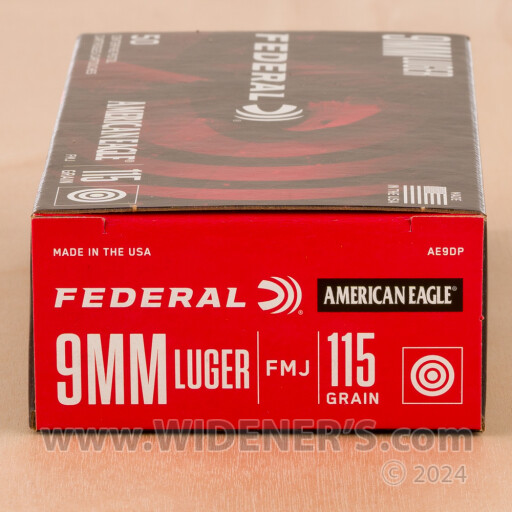

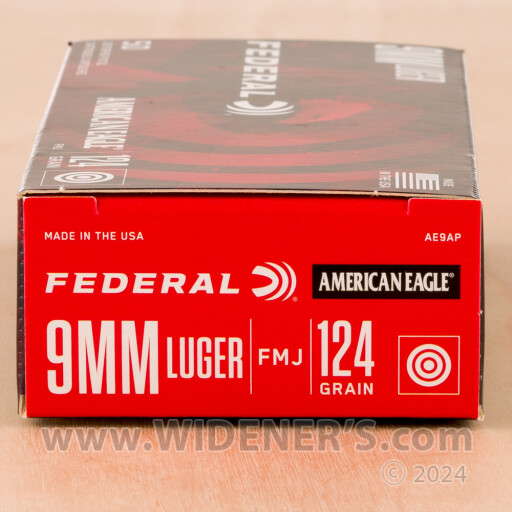






Best 9mm Range Training Ammo (Frangible)
Don’t confuse these for plinking cartridges; yes, you could use these for the job but these are higher-end cartridges intended for serious range training. With reduced lead levels, these cartridges could be better for your health.
Federal Syntech Action Pistol 9mm 150 Grain TSJ
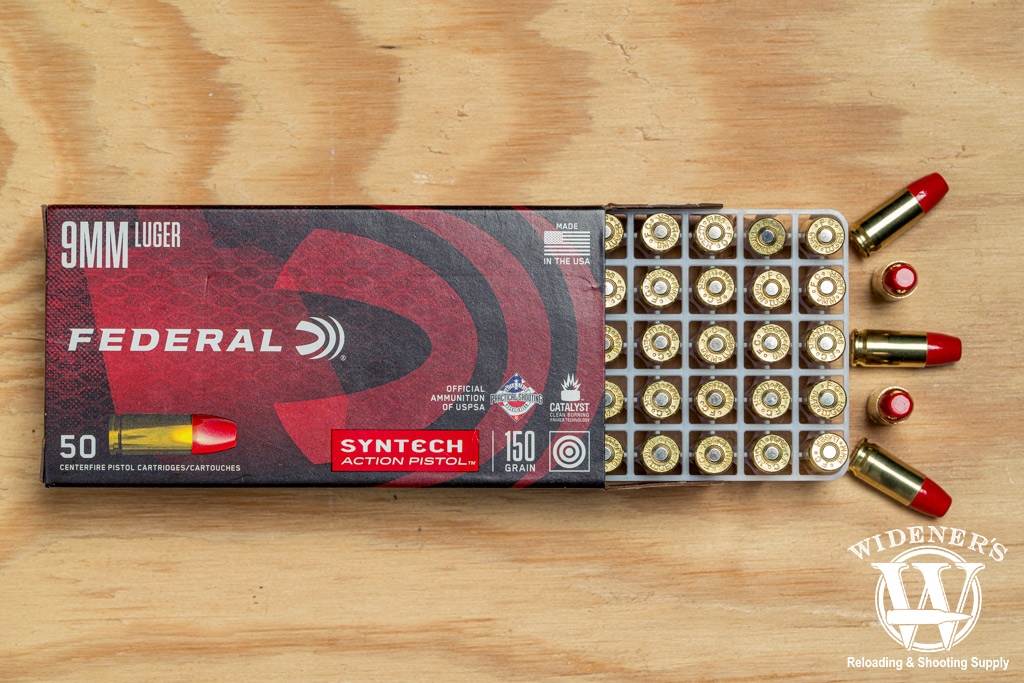
Federal’s TSJ bullet prevents metal-on-metal barrel fouling, heat, and friction damage, all while while reducing exposure to lead.
Tailored specifically for the USPSA crowd, Syntech Action Pistol is a total synthetic jacket with a fully encapsulated lead core bullet. To further reduce the hazard of lead exposure, the primer is also lead-free. The 150gr frangible slug is designed to mimic self-defense loads so you can ensure your range time is practical and useful for real-world environments.
| Caliber | Bullet Type | Bullet Weight | Velocity (Muzzle) | Energy (Muzzle) | 25 Yards (Velocity/Energy) | 50 Yards (Velocity/Energy) | 100 Yards (Velocity/Energy) |
|---|---|---|---|---|---|---|---|
| 9mm | FMJ | 150gr | 890 FPS | 264 FT LBS | 873 FPS/254 FT LBS | 857 FPS/245 FT LBS | 827 FPS/228 FT LBS |

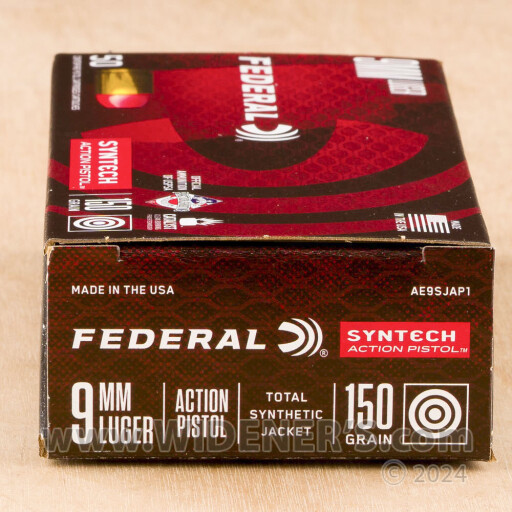
American Eagle Lead-Free 9mm 70 Grain IRT
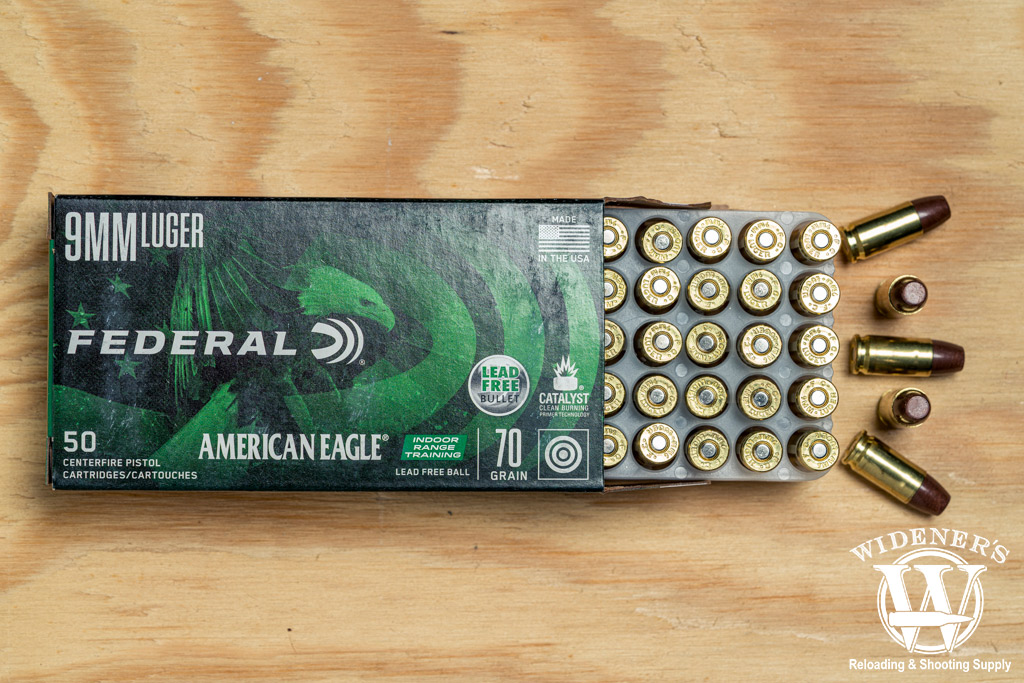
Clean up your range time with lead-free Federal American Eagle IRT ammo.
Federal’s American Eagle Lead-Free IRT ammo is designed for indoor range use. It features a lead-free primer, and an IRT frangible bullet to reduce your exposure to toxic metals. It runs clean in your firearm, reducing barrel fouling and residue buildup. Not only does it have a longer shelf life than most comparable lead-free rounds, but it’s also priced competitively for those who like to spend long days training and perfecting their skills.
| Caliber | Bullet Type | Bullet Weight | Velocity (Muzzle) | Energy (Muzzle) | 25 Yards (Velocity/Energy) | 50 Yards (Velocity/Energy) | 100 Yards (Velocity/Energy) |
|---|---|---|---|---|---|---|---|
| 9mm | IRT | 70gr | 1,625 FPS | 410 FT LBS | 1,457 FPS/330 FT LBS | 1,312 FPS/268 FT LBS | 1,096 FPS/187 FT LBS |









Best 9mm Self-Defense & Duty Ammo
Don’t get caught off-guard with the wrong ammo in your gun. These self-defense options aren’t just recommended, they’re proven. Ask a LEO what they carry in their duty gun, and it will likely be one of these options.
Federal LE Tactical HST 9mm +P 124 Grain JHP
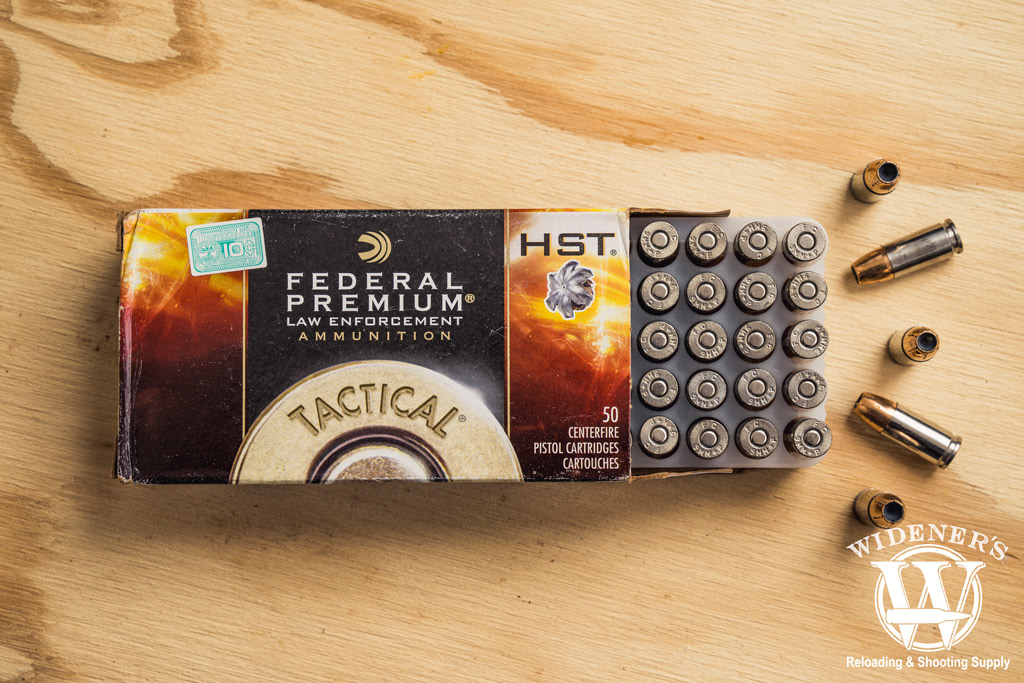
Federal HST ammo is designed to perform and meet the standards required by law enforcement agencies.
For duty and serious self-defense applications, plus-pressure, or “+P” cartridges are the norm. As a caution, make sure your firearm is rated for +P before firing them or disastrous results can occur.
The Federal LE HST 9mm is a mean round, pushing along at a powerful 1,200ft/s with nearly 400ft/lbs of energy. There’s a reason law enforcement agencies use Federal HST ammo on the job, it’s reliable, consistent, and deadly.
| Caliber | Bullet Type | Bullet Weight | Velocity (Muzzle) | Energy (Muzzle) | 25 Yards (Velocity/Energy) | 50 Yards (Velocity/Energy) | 100 Yards (Velocity/Energy) |
|---|---|---|---|---|---|---|---|
| 9mm | JHP | 124gr | 1,200 FPS | 396 FT LBS | 1,136 FPS/355 FT LBS | 1,083 FPS/323 FT LBS | 1,002 FPS/277 FT LBS |
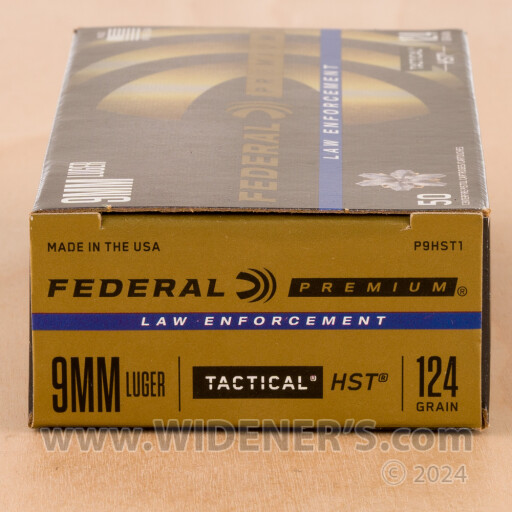
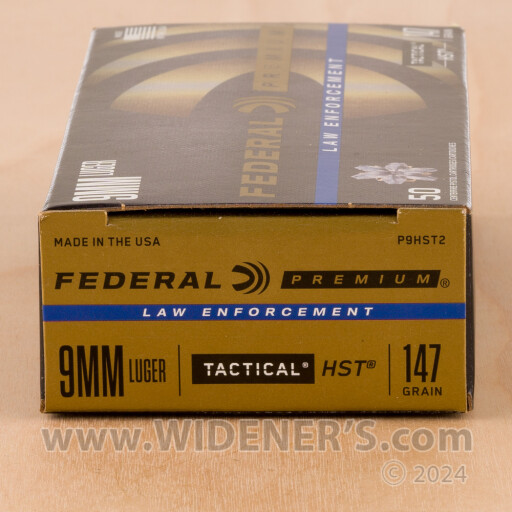





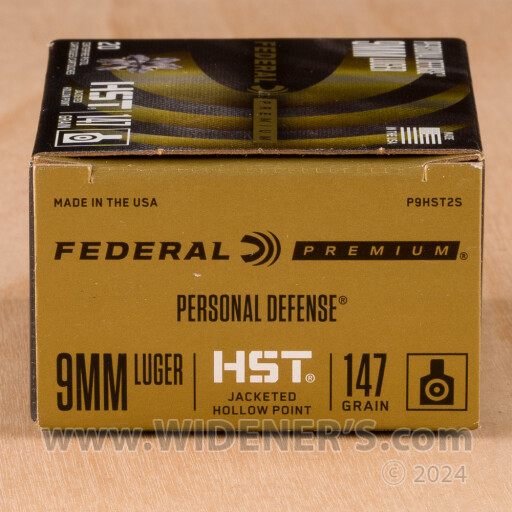



Hornady Custom 9mm 124 Grain XTP JHP
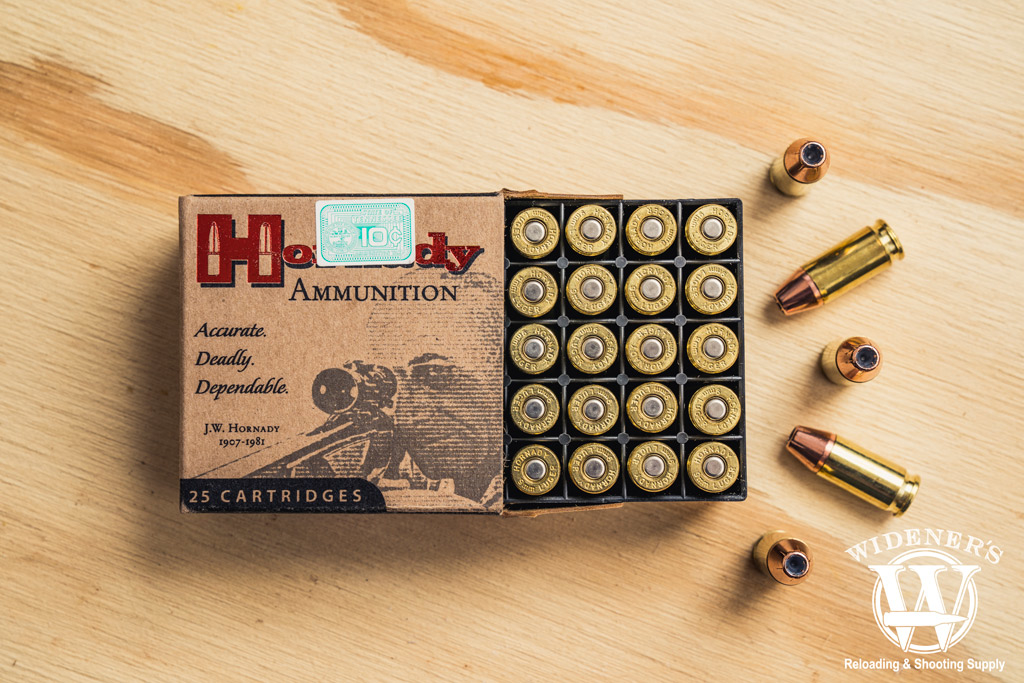
The Hornady XTP product line is hand-inspected to ensure the highest levels of quality control.
Hornady is the household name in good ammunition and that is so because they deliver. The Custom 124gr XTP is a pit bull; it goes for the throat and never let’s go. They are designed to put the target down with a few rounds as possible. You can expect a velocity of 1,110ft/s in the standard pressure 124gr XTP, with 339ft/lbs of energy to stop the threat on the spot.
| Caliber | Bullet Type | Bullet Weight | Velocity (Muzzle) | Energy (Muzzle) | 25 Yards (Velocity/Energy) | 50 Yards (Velocity/Energy) | 100 Yards (Velocity/Energy) |
|---|---|---|---|---|---|---|---|
| 9mm | JHP | 124gr | 1,110 FPS | 339 FT LBS | 1,052 FPS/305 FT LBS | 1,027 FPS/290 FT LBS | 965 FPS/257 FT LBS |
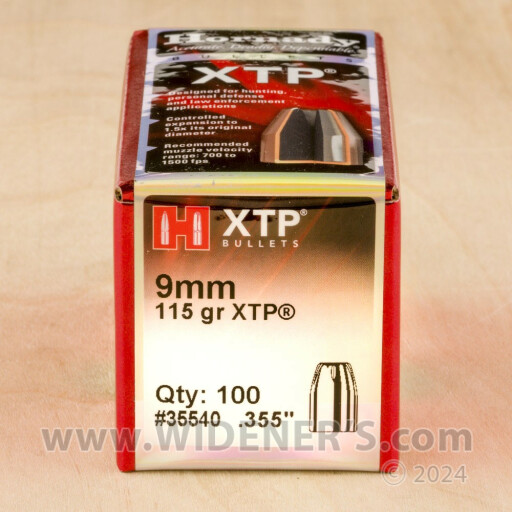
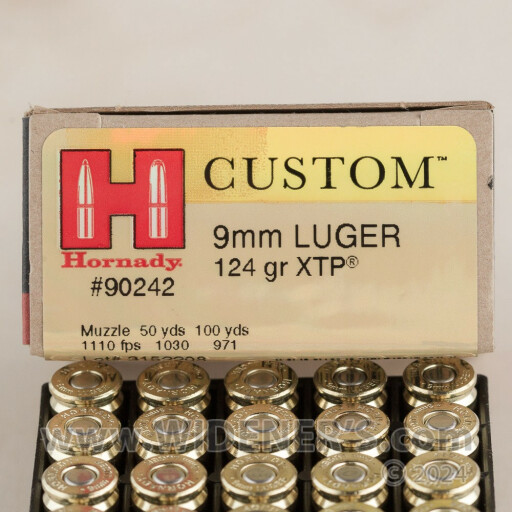
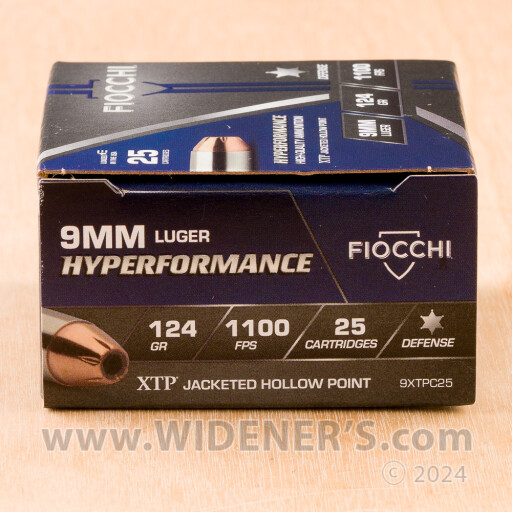


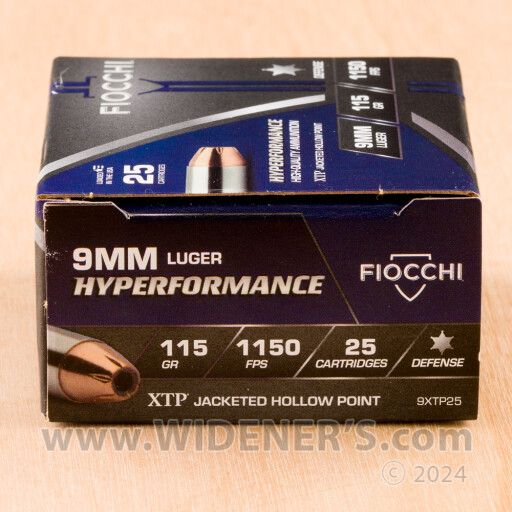

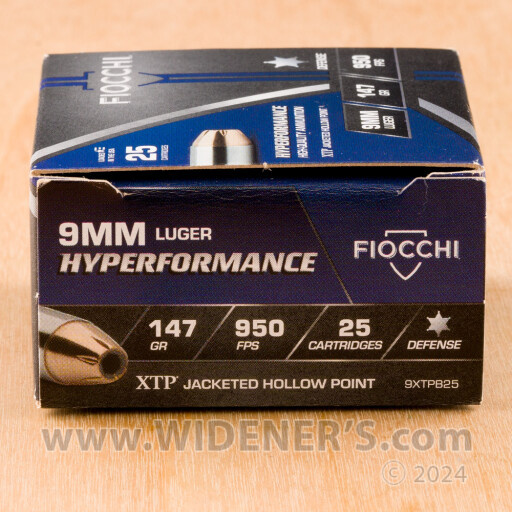
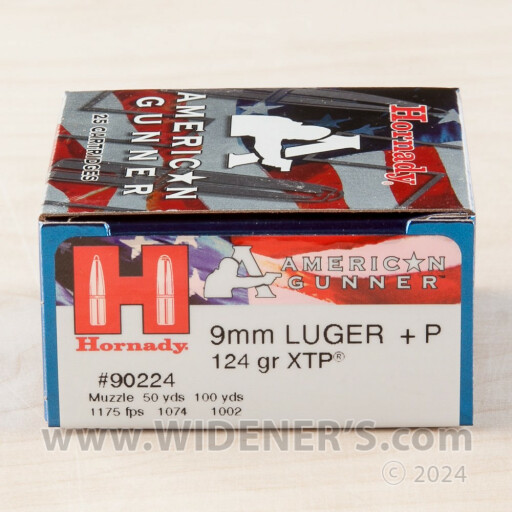

Cartridge Specs
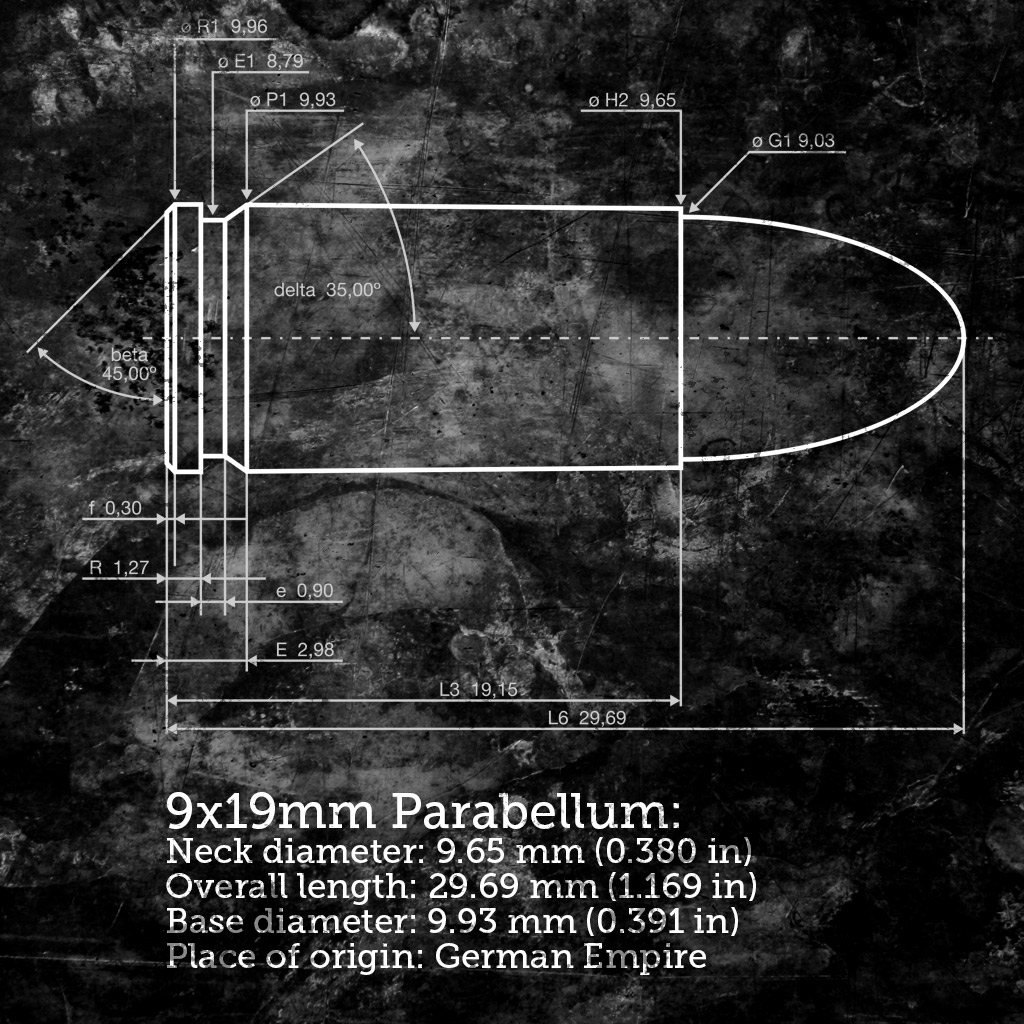
The 9mm cartridge has more power than the .380 ACP round, and its manageable recoil makes it a good option for most users.
9mm offers reliable performance with industry-standard handgun ballistics. It typically comes in bullet weights ranging from 60 to 158 grains, with 115gr, 124gr, and 147gr being the most common options. It’s designed to be used in striker-fire semi-auto pistols, however, it’s also found in revolvers, and pistol-caliber carbine guns. In terms of size, it’s larger than a .380 ACP bullet and has an effective range of around 100 yards.
| Cartridge Specs | 9mm |
|---|---|
| Parent Casing | 7.65x21mm |
| Bullet Diameter | .355″ |
| Neck Diameter | .380″ |
| Base Diameter | .391″ |
| Case Length | .754″ |
| Overall Length | 1.169″ |
| Grain Weight | 60-158gr |
| Max Pressure (SAMMI) | 35,000 PSI |
Best 9mm Ammo Bullet Types
There are a few common types of ammunition readily available in the 9mm: full metal jacket ball, frangible, and jacketed hollow points. Yes, there are other types but they are not as mainstream.
Ball Ammo (FMJ)
The full metal jacket (FMJ) is the most common ball ammo in production. It is produced in bulk both domestically and imported. Much of which is in the form of steel-cased of Russian origin. This is going to be your go-to for plinking and brushing up on skills.
Frangible Ammo
These rounds are made for range training in close quarters or indoor environments. Frangible ammo is usually lead-free, or features a coating over the lead core to keep the user from exposure. The unique thing about frangible ammunition is that it breaks apart into small, fragmented pieces when impacting a hard surface.
Jacketed Hollow Point (JHP)
JHP’s are the most diverse type of projectile used in 9mm platforms. It is also the option with the widest range of bullet weights. Common bullet weights range from 115gr, up to 158gr subsonics, all depending on what the shooter feels is the most pressing need.
115gr JHPs are the fastest and flattest shooting, which isn’t all that often an issue in realistic tactical shooting. The 115gr and the 124gr JHPs are best suited for self-defense applications in close quarters when you have to worry about bullet penetration depth. The 147gr JHP is the best option for situations where high-velocity rounds with deep penetration are needed to stop a potential threat.
History Of The 9mm Cartridge
Firearms are a curious mix of old and new, and old becoming new again. Many if not most of the most popular calibers in use today are over a century old. The .45 ACP was designed in 1905, the .38 S&W Special in 1898, the 9x19mm Parabellum, or Luger, in 1901. These still represent much of the stable of the most common of handgun calibers in the world.
All of these were designed to improve upon the shortcomings of previous calibers, many of which were still based on black powder. While revolvers maintained their status on the hips of patrol officers and troopers for many decades after the turn of the 20th century, armies of the world understood the way forward was with the semi-automatic pistol.
Georg Johann Luger designed the 9x19mm in 1902, adapting it from the 7.65x21mm Parabellum which he also designed slightly earlier. Ironically, he pitched the cartridge and the infamous and iconic Luger pistol to the British, the U.S., and German armed forces prior to World War I commencing. The German Navy ultimately adopted it in 1904 and the German Army followed suit just four years later.
The 9mm At War
Germany employed the caliber prior to The Great War and still retains it as their standard sidearm caliber to this day, as do most other Western nation’s militaries. They also adopted it to their submachine guns, most notably the MP 40. Unlike so many obsolete or forgotten calibers, the 9mm exploded in use after WWII.
With more than a note of irony, the Israeli-designed Uzi series of submachine guns were chambered in it, as well as the world-famous Heckler & Koch MP5. Glock and Beretta created the pistols which were dubbed “Wonder Nines” because of their high capacity and relatively compact sizes, and become overnight Hollywood sensations (even though the Beretta design was far from new), along with Uzis and MP5s.
9mm Quick Answer Box:
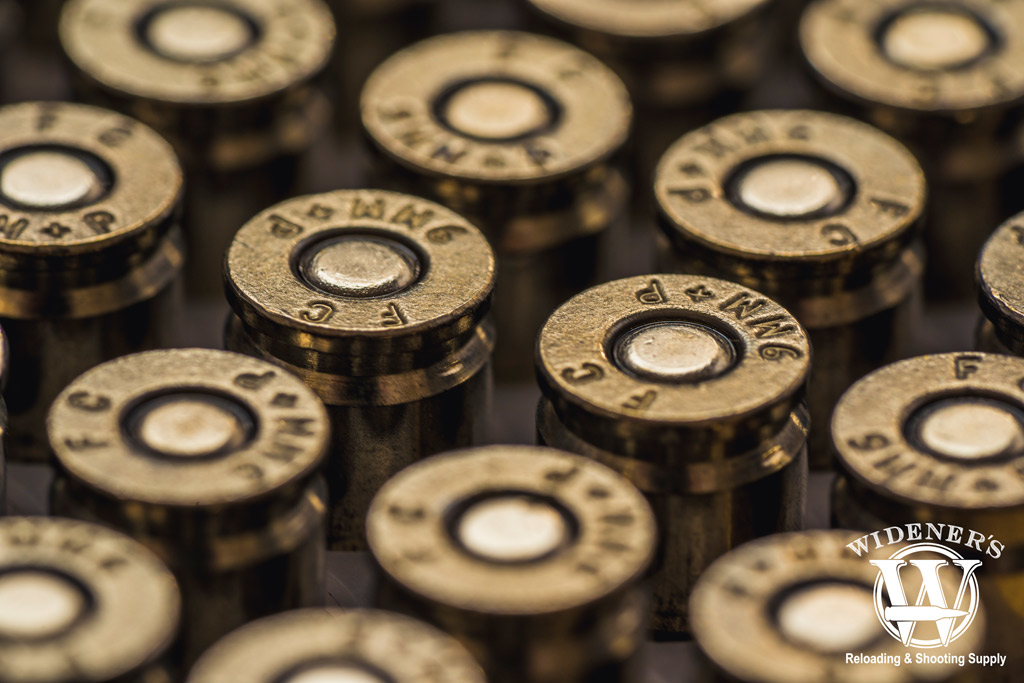
The 9mm cartridge is the most widely used pistol caliber in the world.
Is the 9mm a good choice for self-defense?
In a word, absolutely. The law enforcement community would not continue to use it if it were not. The consumer market also votes with its wallet. There’s a reason the 9mm only continues to grow in popularity. It’s also the first caliber that every newly released semi-auto handgun is chambered in. Manufacturers use 9x19mm because they know it will sell.
Munition design is the determining factor in the lethality of a caliber, within reason. The .355” diameter of the 9mm bullet is capable of plenty of power, as evidenced by the .357 Magnum. With a good, dedicated defense load the 9mm is very lethal. As the adage goes, shot placement is as important as displacement (again, within reason). With the significantly lower cost of shooting the 9mm, improving your accuracy is easier if the ammo is cheaper.
Should I buy a pistol or carbine in 9mm for home defense?
You should buy both! In all seriousness, 9mm is the most common handgun caliber in the world for a reason. It’s inexpensive, easy to find, has very manageable recoil, and is accurate. It’s great in duty-sized weapons for follow-up shots, and the standard magazine capacity ranges from 12-19+1.
Manufacturers of the full-size duty pistols scaled them down to make popular compact and subcompact models. The sub-compacts are roughly the size and bulk of a 5-shot snubby revolver. However, they routinely carry 10+1 to 12+1 cartridges, depending on the make and model. There are a number of very good and inexpensive single-stack 9mm semi-automatics tailored for deep concealment.
The 9mm carbine concept is not new, it was introduced a number of years ago by Marlin and Ruger. Those earliest forays were widely accepted as quality weapons but the timing was just off. Colt also has a 9mm variant of the AR-15, but it is costly and uses a proprietary magazine.
However, don’t let that put you off in your search for a 9mm carbine. There is a slew of 9mm AR spinoffs that have lower receivers built to use the common Glock magazines, along with Ruger’s brand new PC carbine which uses Ruger magazines, and includes an adapter for Glock mags as a standard item.
9mm VS 40 S&W VS 45 ACP: What’s the difference?
The big three automatic pistol calibers, obviously each have their own strengths. Each is incrementally larger than the previous by .05” which does not seem like much until you look down the barrel of each (make sure the gun is unloaded) and inspect the size of the bore.
The .40 S&W is the newcomer by nearly a century, being adapted by shortening the 10mm Automatic cartridge. The idea was to take some of the sting out of the thunderous 10mm. For the most part, it worked. Most major manufacturers offer similar frame pistols in both 9mm and .40 S&W. The .45 ACP cartridge is larger, so it must have larger components to fire it. Full-size pistols in .45 ACP are always a little bit bigger than the other two and lower in capacity (S&W MP9 has 17+1 to the MP45s 10+1).
Ammunition design and performance have improved dramatically since the .40 S&W went into production in the early 1990s. At the time, it really appeared that the .40 would render the 9mm all but obsolete. It had a lot of the big bore oomph of the .45 ACP but retained the capacities of popular 9mm pistols. However, the .40’s recoil is considerably sharper than the 9mm, and the ammo is more expensive. Both of those factors have caused it to fall in popularity in recent years.
Best 9mm Ammo: Capacity, Recoil, & Reliability

The benefits of the 9mm cartridge easily make it one of the best choices for consumers.
There remains some discussion in the industry about whether you should buy a 9mm and if it is a reliable self-defense sidearm. At this point, there’s enough real world data available to quell any naysayers. Yes, it is a true contender for the best all-round cartridge and an excellent self-defense option. With good ammunition, it has no problem putting down threats quickly and efficiently.
The best 9mm ammo is consistently more powerful and accurate than the .380 ACP, or .38 Special. It has less felt recoil and about three times the capacity of most revolvers. Also, carbines in this chambering have become very popular due to the low cost of ammunition. Good terminal ballistics for targets under 200 lbs, make it a viable self-defense option. All in a package with almost no felt recoil and much less noise than a rifle caliber carbine.
If you do not yet own a 9mm, you should change that. It truly is a caliber for nearly everyone.


